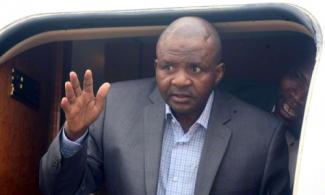
“The pilot was not certified, qualified and not competent to fly the aircraft... the decision of the pilot to operate a VFR flight after sunset and the inadequate oversight by the regulatory authority," Akin Olateru, the Commissioner of AIB, said on the causes of the crash.

Danbaba Suntai, the late former Governor of Taraba Sate, was not “competent, qualified and certified” to fly the Cessna aircraft that crasked in October 2012 and resulted in his death five years later, the final report of the Accident Investigation Bureau (AIB) released on Thursday has revealed.
In its final report on another crash, Bristow Helicopters’ Sikorsky S76C++ helicopter with the registration number: 5N-BQJ, which occurred at 77NM offshore from Murtala Muhammed Airport, Ikeja on Radial 139o on February 3, 2016, AIB also said that the pilot did not adhere to the company operations manual (Part B checklist) as it relates to after-take-off checks.
Akin Olateru, the Commissioner of AIB, made these revelations at the agency’s headquarters at the Murtala Muhammed International Airport (MMIA), Lagos, during the release of six accidents and incidents reports on crashes that occurred at different times within the country.
About the final report of Suntai's crash, Olateru further said that the decision of the pilot to operate a Visual Flight Rating (VFR) after sunset contributed to the accident, which involved four persons onboard.
The accident had occurred at Kwanan-Waya Village, Yola South Local Government Area of Adamawa State at past 7pm; meanwhile, the VFR in which the pilot was qualified to fly ends at 6pm.
The Governor had piloted a Cessna 208B Caravan aircraft with the registration number 5N-BMJ, but was rated on Cessna 172 aircraft.
The report also revealed that the aircraft was not registered on any Aircraft Maintenance Organisation (AMO), while the Nigerian Civil Aviation Authority of Nigeria (NCAA) could not trace the history of the aircraft.
But a source close to NCAA confided in our correspondent that the aircraft was acquired from Ibn Na’Allah, the Kebbi South senator.
Although AIB said it could not conclusively determine the cause of the accident, it noted that the pilot only had 58hrs, 40mins flying hours.
In its safety recommendation on the accident, the AIB advised the Nigerian Airspace Management Agency (NAMA) to take appropriate action to relocate the existing control tower at Yola Airport in a bid to improve the aerial view of the approach path of runway 35 from the tower.
According to the report, Suntai also lied about the number of persons on board to the control tower. The report claimed that Suntai had told the control tower that six persons were on board the aircraft, but findings after the crash, revealed that only four souls were aboard.
The report further emphasised that investigators could not interview Suntai after the crash, as he was immediately flown abroad for intensive treatment.
“The pilot was not certified, qualified and not competent to fly the aircraft... the decision of the pilot to operate a VFR flight after sunset and the inadequate oversight by the regulatory authority," he said on the causes of the crash.
“NAMA should take appropriate action to relocate the existing control tower at Yola Airport in order to enhance the aerial view of the approach path of runway 35 from the tower.
“NCAA should ensure all pertinent regulations with regards to the operations of the aircraft and certification of all relevant personnel and facilities of the Ministry of Works and Transport, Taraba State Government are appropriately complied with.”
On the Bristow Helicopter crash of February 3, 2016, AIB reported that the crew switched the Compass to “FREE” DG mode for Landing on the helideck at Erha FPSO, and did not return to the “SLAVE” mode after take-off, which caused the trim fail to cut off consistently, which in turn disengaged the autopilot as a result of the unsynchronised heading inputs.
The report in the contributory factor of the crash said that the accident occurred because of non-adherence to Company Operations Manual (Part B checklist) as it relates to after-take-off checks, adding that the crew did not disengage the autopilot to fly the aircraft manually.
It also recommended four safety recommendations to Bristow and other concerned bodies in the industry on the crash.
AIB recommended that Bristow should ensure that annual flight recorder readout is carried out for every aircraft in their fleet in accordance with NCAAOrder 001 2014 and ICAO Annex 6 Part III.
Also, Bristow Helicopters should ensure that the annual flight recorder readouts records obtained should be preserved with appropriate current data frame layout, stressing that the company should ensure that flight crew followed approved checklist items, and procedures at all times.
It also recommended that Bristow Helicopters should consider reviewing their procedure for returning crew back to flight duties after staying out of flight duty for any period up to 30 days.